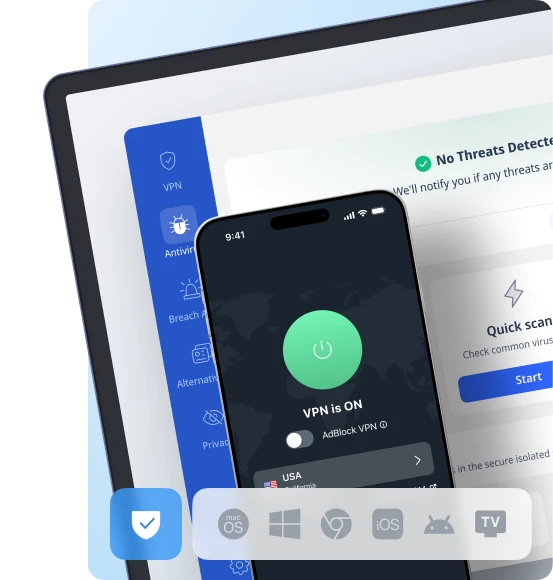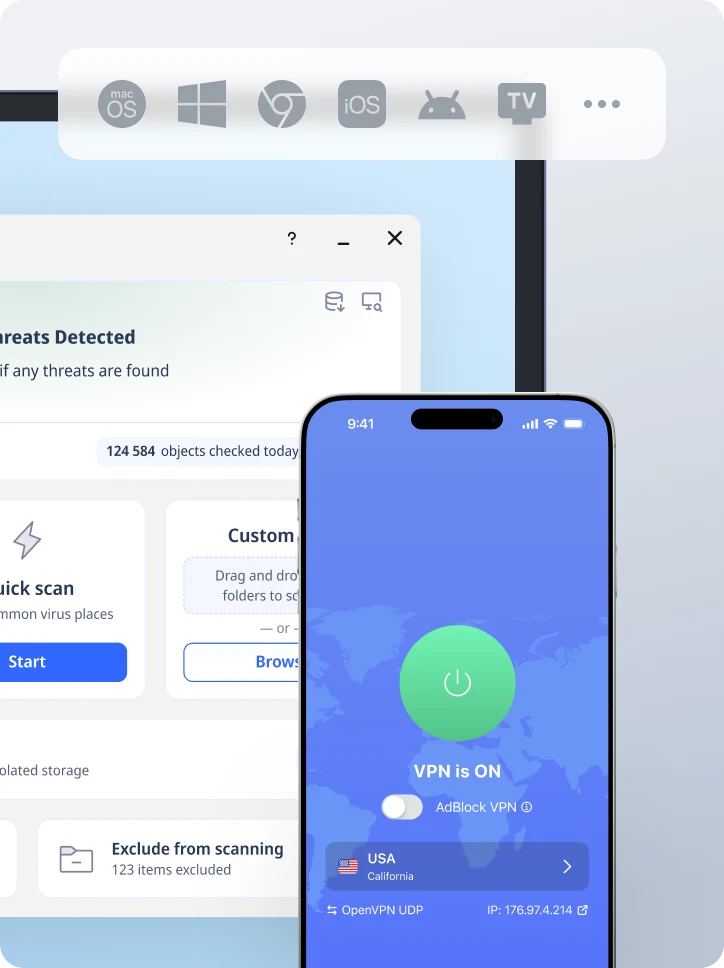What Is Cryptomalware and How to Stay Safe Online
Imagine waking up, turning on your computer, and finding all your files: photos, work documents, tax records encrypted, with a message demanding payment to get them back. No warning, no explanation, just a digital ransom note. Cryptomalware is a disruptive virus that can cripple your system and productivity instantly. That’s the nightmare of cryptomalware and it’s more common than you think.
This article will explain how cryptomalware works, what it targets and most importantly how you can avoid it with a special focus on how a VPN like VeePN can help you.

Why you need VeePN to stay safe
Before we get into the tech talk, let’s discuss what keeps you safe. Cryptomalware attacks through shady connections — unsecured networks, phishing emails or sketchy downloads. That’s where VeePN shines:
- Encrypts all your Internet traffic so hackers can’t spy
- Hides your real IP address so you can’t be targeted
- Blocks access to known malicious websites and trackers
- Protects you on public WiFi where cryptomalware thrives
- Supports up to 10 devices with one subscription
- 2,500+ servers in 89 locations for ultra-secure browsing
To further reduce the risk of cryptomalware infection, always download software only from trusted or official sources.
With VeePN on your side you’re already two steps ahead of most online threats.
What is crypto mining malware
Cryptomalware or ransomware is a type of malware that is a malicious program designed to extort victims:
- Encrypts files and data on your device
- Locks you out of your system
- Demands payment (usually in cryptocurrency) to unlock your files
- Often includes a countdown timer to pressure payment
- Can spread across networks and infect entire organizations
It’s not about stealing your data, it’s about holding it hostage.
Types of malware
Malware, which is an abbreviation of malicious software, has multiple modes of operation that harm your gadgets and information. As far as the crypto malware is concerned, some types can be named as particularly harmful:
👾Cryptomining malware: This is the malware that goes behind your back and uses your computer to mine cryptocurrencies such as Bitcoin or Monero. Attackers can mine cryptocurrency on your computer without your permission and knowledge and make your computer work slower, while all the time the mined coins go to the hacker.
👾Ransomware This is a traditional type of malware that takes control of the data in your machine by encrypting them and then charges a ransom to give you the decryption key typically in digital currency. The victims are denied access to their personal data and the attackers warn them of the irrecoverable loss unless ransom is paid.
👾Crypto ransomware: This is a cross between the two evil forces. It does not only encrypt files and request ransom, but it also uses the resources of your computer to mine the cryptocurrencies in the background. This entails you being ransomware attacked and your system performance being greatly affected.
👾Trojans and spyware: These are malicious apps which can be used by the attackers to get unauthorized access into your computer. Being inside, they can install cryptomalware or do other evil things and steal the information that is sensitive or watch you what is going on.
By knowing these kinds of malware, you can take the first step towards protecting your gadgets against cryptomalware attacks.
How cryptomalware works and uses processing power
The procedure can be seen as follows:
👹Infiltration: An attacker, or threat actor, first accesses with the help of phishing emails, vulnerability of well-known exploits, or masking malware-like legitimate software.
👹Delivery: The crypto malware activity is the execution as a malicious software on the victim machine or the victim computer and usually mines cryptocurrency or cryptocurrencies without the knowledge of the victim that may consume a lot of resources on the victim machine. Advanced methods of evasion such as shutting down antivirus software or use of windows management instrumentation are applied in some of the variants.
👹Demand: A ransom note has been received with the demand of payment in crypto.
👹Propagation: The infecting device can be used by the attacker or threat actor to infect other devices of the victims with the crypto malware attack and in some cases they can be used along with other malware to enhance their malicious nature.
A typical aim of cryptomalware is cryptocurrency mining and the malware might be trying to mine block headers. Cryptomalware is unique compared to the rest of the malware because it is targeted at illegal cryptocurrency mining and system disturbance.
How cryptomalware spreads
Crypto malware does not suddenly appear: it is distributed by attackers with a number of different tactics that aim at either deceiving or duping the user. The following are some of the ways through which these threats are usually introduced in your device:
☠️Phishing emails: This is one of the most popular ways as phishing emails are made to appear real, but their links or attachments are harmful. The tapping on these may even put on crypto malware or other malicious codes on your system.
☠️Infected software downloads: Downloading of software is dangerous when it is done on some untrusted or unofficial sources. Fraudsters usually pack malware in seemingly harmless programs and therefore, when you download the software, you end up downloading crypto malware.
☠️Malicious websites: Just by visiting a malicious or a compromised site, one can end up downloading malware to the device. The sites can use the weaknesses of your browser or operating system to install crypto mining malware against your knowledge.
☠️Taking advantage of weaknesses: Hackers are constantly searching the web to find out well-known weaknesses in operating systems, browsers and applications. In case your software is not up-to-date, it is possible to use these vulnerabilities and deliver crypto malware straight to your computer.
☠️Infected USB drives: Just by plugging in an infected USB drive (one with malware on it) to your computer, it is possible that malicious software, including crypto malware, can be installed automatically on your computer.
Being aware of the spread of crypto malware, you will be more watchful and prevent becoming the victim of the most dangerous attack vectors.
Who cryptomalware targets
Nobody’s safe. This malware targets:
- Everyday users with personal data on their devices
- Small businesses with limited IT security
- Corporations with valuable sensitive information: hospitals, schools and government agencies.
Real-world examples
Here are some real-world examples of crypto malware and crypto ransomware attacks:
These high-profile attacks show just how bad cryptomalware can be:
- WannaCry (2017): One of the most famous crypto ransomware attacks, WannaCry hit over 200,000 computers in 150 countries. It affected the UK’s National Health Service, causing cancelled surgeries and mass disruption.
- NotPetya (2017): Originally targeted at Ukraine, NotPetya spread globally and affected companies like Maersk, FedEx and Merck. The total damage was over $10 billion. Unlike traditional ransomware NotPetya was designed more for destruction than financial gain.
- Ryuk: This ransomware targeted hospitals and public services, especially in the US. In one case Ryuk delayed medical services, forcing hospitals to go back to paper-based systems.
- Colonial Pipeline (2021): This major US fuel supplier had to shut down operations due to a ransomware attack, causing gas shortages and price spikes across the East Coast. The company made ransom payments of $4.4 million in Bitcoin to the attackers to regain access to their systems.
- Baltimore city government (2019): A RobinHood ransomware attack locked city employees out of their emails and systems for weeks, costing the city over $18 million in recovery and damages.
Other examples of crypto malware include cryptojacking worms, which are designed to spread across networks and infect multiple endpoints to mine cryptocurrencies like Monero, often by exploiting vulnerabilities in systems or container platforms such as Docker. The Prometei botnet is another example, operating as a dynamic malware network that infects computers across Europe and the US, exploiting vulnerabilities like Microsoft Exchange, EternalBlue, and BlueKeep to deploy crypto-mining malware and harvest credentials without the owners’ knowledge.
These examples show cryptomalware isn’t just a personal threat, it’s a national and global issue.
Crypto mining: The hidden danger
Crypto mining may not be a very dangerous activity but when you do it without enough knowledge, it can be very dangerous. Crypto mining malware is malware that is meant to steal processing power on your device to mine cryptocurrencies on behalf of cybercriminals and the consequences of such can be rather extensive:
⚠️Resource drain: Your use of CPU can increase extremely as a result of crypto mining malware bringing your computer to a crawl, making normal operations painfully slow. Such consumption of more resources also results in an increase in the electricity bills, and may even reduce the life span of your hardware.
⚠️Security risks: Once crypto mining malware is detected, it is a sure indication that there is a breach of security on your system. Other malware or theft of sensitive information can also be installed by attackers that have access to your device to do mining.
⚠️Financial losses: In addition to the direct expenses of using more energy and hardware wear, organizations may lose a lot of money because of lost productivity, as well as potential lawsuits in case of customer data exposure.
⚠️Rising threats: The value of cryptocurrency declines and increases, so does the motive of cybercriminals to devise new and more complex cryptojacking attacks. This implies that the threat landscape keeps changing with the attackers exploring new methods of targeting vulnerable systems.
Being cautious about the possible threats of crypto mining malware is the only way to make sure that your devices, your data, and your wallet are safe.
What happens if you’re infected and need a decryption key
- You lose access to your files instantly
- Your screen displays a ransom message with payment instructions
- If you pay there’s no guarantee you’ll get your files back
- Refusing to pay means permanent data loss, unless you have backups
Detection and removal
Detection and removal of crypto malware is an active process that needs the appropriate tools. The following are the ways through which you can identify and eliminate crypto mining malware in your devices:
🔎Tracking resource use: Watch over performance of your system. Sudden unexplained CPU usage or network usage may be an indication that background crypto mining malware is operating.
🔎Antivirus software: Use well-known antivirus software that has special protection against crypto malware. Such programs are able to identify, isolate and delete malicious files, before they do any major damage.
🔎Regular updates: Update your operating system and all the software installed on regular basis with new security patches. This assists in sealing the known holes which can be used by the attackers to implant malware.
🔎Network monitoring: Check your network activity on a regular basis to find out any abnormalities or connections. This will assist you to determine infected devices and quarantine them before the malware gets further.
🔎Talk to the professionals: Just in case you feel that your device is infected and you are not able to eliminate the malware by yourself, then do not hesitate and talk to the cybersecurity experts. They have the resources and the skills to clean your system and rebuild your security in an adequate way.
Being attentive and applying the correct tools, you will be able to identify and eliminate crypto malware before it affects your system permanently.
How to prevent crypto malware attacks
Here are practical steps to keep yourself safe:
✅Avoid clicking on unknown links or email attachments
✅Keep your operating system and apps updated to prevent cybercriminals from exploiting security vulnerabilities
✅Back up your data regularly and store it offline
✅Use reputable antivirus programs to detect and block malware, including crypto malware and cryptojacking scripts
✅Limit administrative privileges on your devices
✅Use unique passwords for all your accounts to enhance security
✅Use a virtual private network (VPN) like VeePN to secure your network and block dangerous sites
Following these steps will help prevent crypto malware attacks and prevent cybercriminals from compromising your devices.
Future threats: What’s next for cryptomalware?
The world of crypto malware is always changing, with attackers constantly developing new tactics to bypass security measures. Here’s what the future may hold for crypto malware attacks and how you can prepare:
⛓️Advanced cryptojacking techniques: Expect to see more sophisticated cryptojacking attacks, including those targeting emerging technologies like Internet of Things (IoT) devices, which often lack robust security.
⛓️Increased use of stealth: Malware attacks are becoming harder to detect, with attackers using fileless malware and other techniques to evade traditional antivirus software.
⛓️Ransomware and cryptojacking hybrids: The lines between different types of malware are blurring, with new ransomware variants combining file encryption with crypto mining for maximum profit.
⛓️Greater focus on mobile devices: As smartphones and tablets become more powerful, they’re increasingly attractive targets for crypto malware attacks, putting more users at risk.
⛓️Enhanced protective measures: The good news is that antivirus software and cybersecurity practices are also evolving. Staying informed about emerging threats and keeping your defenses up to date will be crucial in preventing future malware attacks.
By understanding these evolving threats and staying proactive, you can help prevent crypto malware from compromising your digital life.
Why VeePN is your best defense
While antivirus helps after malware hits, VeePN helps stop it before it gets close:
🛡️Hides your digital footprint to avoid targeted phishing or IP-based attacks
🛡️Encrypts your Internet connection to keep attackers out
🛡️Blocks access to malicious content by using secure DNS servers
🛡️Works on public WiFi, prevents man-in-the-middle attacks
🛡️Lets you browse safely in high-risk locations with its global server network
Conclusion
Cryptomalware isn’t just a news headline: it’s a very real threat that can hit anyone. But with the right precautions you can minimize your risk to almost zero. Back up, stay aware and most importantly use VeePN to secure your digital life at the network level.
Get VeePN now, before malware strikes!
VeePN is freedom
Download VeePN Client for All Platforms
Enjoy a smooth VPN experience anywhere, anytime. No matter the device you have — phone or laptop, tablet or router — VeePN’s next-gen data protection and ultra-fast speeds will cover all of them.
Download for PC Download for Mac IOS and Android App
IOS and Android App
Want secure browsing while reading this?
See the difference for yourself - Try VeePN PRO for 3-days for $1, no risk, no pressure.
Start My $1 TrialThen VeePN PRO 1-year plan








